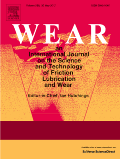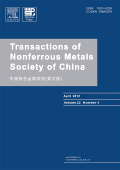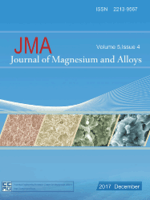
SURFACE REVIEW AND LETTERS
Scope & Guideline
Connecting Scholars through Cutting-Edge Research
Introduction
Aims and Scopes
- Surface Engineering Techniques:
The journal publishes research on various surface engineering methods, including coatings, surface treatments, and modifications that enhance the mechanical, thermal, and corrosion resistance of materials. - Materials Characterization:
A significant focus is placed on the characterization of materials at the micro and nano scales, utilizing techniques such as X-ray diffraction, scanning electron microscopy, and atomic force microscopy to understand surface properties. - Nanomaterials and Composites:
Research on nanomaterials and composites is prevalent, exploring their synthesis, properties, and applications, particularly in enhancing the performance and functionality of traditional materials. - Optimization of Manufacturing Processes:
The journal emphasizes the optimization of various manufacturing processes, including machining, welding, and additive manufacturing, using statistical methods and machine learning techniques. - Tribology and Wear Studies:
A core area of research involves tribological studies, focusing on friction, wear, and lubrication of materials, which is critical for applications in automotive, aerospace, and biomedical fields. - Corrosion Resistance and Inhibition:
The journal covers studies related to corrosion mechanisms, prevention techniques, and the development of corrosion-resistant materials, particularly in harsh environments. - Biocompatible Materials:
There is a growing emphasis on the development and characterization of biocompatible materials for medical applications, including coatings for implants and devices.
Trending and Emerging
- Advanced Surface Modification Techniques:
There is an increasing focus on advanced surface modification techniques, such as laser processing, plasma treatments, and nanostructuring, which enhance material properties at the nanoscale. - Machine Learning and AI in Materials Research:
The integration of machine learning and artificial intelligence in optimizing surface engineering processes and predicting material behaviors is gaining traction, showcasing the intersection of traditional materials science with modern computational techniques. - Sustainable Materials and Green Chemistry:
Research on sustainable materials, including biodegradable composites and environmentally friendly surface treatments, is emerging as a significant theme, reflecting global trends toward sustainability. - Smart Materials and Sensors:
The development of smart materials with embedded sensors for real-time monitoring of surface conditions and performance is becoming increasingly relevant, particularly in biomedical and aerospace applications. - Interdisciplinary Approaches:
Emerging interdisciplinary research that combines surface engineering with fields such as biology, electronics, and environmental science is on the rise, indicating a broader application of surface engineering principles.
Declining or Waning
- Traditional Coating Techniques:
Research on conventional coating methods, such as electroplating and basic thermal spraying, appears to be waning as more advanced techniques like additive manufacturing and novel nanostructured coatings gain prominence. - Basic Material Studies:
There is a reduction in studies focused solely on the fundamental properties of materials without application to surface modifications or engineering, reflecting a trend toward applied research. - Single-Material Studies:
The journal is moving away from papers that focus solely on single-material studies in favor of multi-material composites and hybrid approaches that offer enhanced properties. - Low-Impact Studies:
Research that does not demonstrate significant practical applications or advancements in surface engineering is less frequently accepted, as the journal prioritizes impactful studies that can drive innovation.
Similar Journals

Advances in Materials Research-An International Journal
Driving Excellence in Materials Science ResearchAdvances in Materials Research - An International Journal is an esteemed publication in the field of materials science, spearheaded by TECHNO-PRESS. Established to provide a critical platform for the dissemination of high-quality research, this journal focuses on a broad spectrum of topics, including Biomaterials, Ceramics, Composites, Electronic, Optical, Magnetic Materials, Metals, Alloys, and Polymers. With a commendable impact factor reflecting its substantial contribution to the scientific community, Advances in Materials Research promotes innovative ideas through rigorous peer-review processes and supports the continuous advancement of materials research, particularly in the dynamic environment of South Korea. This journal, which holds impressive rankings across various subfields in the Scopus database, is designed to cater to the needs of researchers, professionals, and students aiming to stay at the cutting edge of materials science. By bridging gaps between theory and application, it invites contributions that push the boundaries of knowledge and technology in diverse material applications.

WEAR
Fostering Dialogue in the World of Wear and FrictionWEAR is a premier journal published by Elsevier Science SA, specializing in the field of materials science, particularly in the dynamics of wear and friction at the micro and nanoscale. Since its inception in 1957, this esteemed journal has evolved into a critical resource for researchers, professionals, and students alike, showcasing cutting-edge research and developments that significantly impact the disciplines of Condensed Matter Physics, Mechanics of Materials, Materials Chemistry, and Surfaces and Interfaces. With an impressive impact factor and consistently recognized as a Q1 category journal across various Scopus rankings, WEAR ranks in the top tiers of its field, underscoring its importance and influence within the academic community. The journal serves as a vital platform for disseminating innovative findings and applications, fostering scholarly dialogue, and advancing the understanding of material behaviors under wear and friction processes. For those keen on accessing the latest research in these dynamic areas, WEAR is an indispensable resource, promising a comprehensive collection of high-quality articles that reflect the forefront of scientific inquiry.

TRANSACTIONS OF NONFERROUS METALS SOCIETY OF CHINA
Exploring innovations in metals and engineering solutions.TRANSACTIONS OF NONFERROUS METALS SOCIETY OF CHINA, published by Elsevier, is a premier academic journal that serves as a vital platform for researchers and professionals specializing in materials science, condensed matter physics, geotechnical engineering, and engineering geology. Established in 1994, this esteemed publication has maintained a robust focus on the latest developments in the nonferrous metals sector, reflecting its significant impact in the field with a Q1 categorization across multiple disciplines. With impressive Scopus rankings—placing it in the top 20% of journals in relevant categories—this journal is recognized for its quality and rigor, providing critical insights into metals and alloys, materials chemistry, and their applications. The non-open access format ensures a dedicated readership among professionals and academics seeking substantial and authoritative research articles. By fostering knowledge exchange, the journal strives to advance the understanding and application of nonferrous metals, making it an essential resource for anyone involved in material innovations and engineering solutions.

Protection of Metals and Physical Chemistry of Surfaces
Advancing Knowledge in Surface Chemistry and Metal ProtectionProtection of Metals and Physical Chemistry of Surfaces is a prominent academic journal published by MAIK NAUKA/INTERPERIODICA/SPRINGER, which provides a specialized platform for researchers and professionals in the fields of materials chemistry, metals and alloys, organic chemistry, as well as surfaces, coatings, and films. With an ISSN of 2070-2051 and an E-ISSN of 2070-206X, the journal is recognized for its rigorous peer-reviewed content and comprehensive coverage of innovative research addressing the latest advancements in material protection and surface chemistry. As of 2023, the journal has been categorized in the Q3 quartile across several relevant fields, highlighting its increasing influence within the scientific community. Although the journal is relatively niche, its open access model encourages wide dissemination of knowledge, fostering collaboration and advancements within its core disciplines. Research published in this journal plays a crucial role in not only enhancing theoretical understanding but also facilitating practical applications in various industries, thereby underlining its importance for students, researchers, and professionals alike.

Korean Journal of Metals and Materials
Empowering Scientific Discovery in Metals and MaterialsWelcome to the Korean Journal of Metals and Materials, a premier publication dedicated to advancing research in the interdisciplinary fields of metals and materials science. Published by the Korean Institute of Metals and Materials, this journal aims to foster the dissemination of innovative findings and significant developments across various domains, including electronic, optical, and magnetic materials, metals and alloys, as well as modeling, simulation, and surface coatings. With a commendable Q3 quartile ranking in several relevant categories as of 2023, it serves as a vital resource for researchers, professionals, and students interested in the latest scientific trends and technological applications. The journal has successfully converged from 2007 to 2024, showcasing a rich archive of knowledge. Engaging with this publication gives readers the opportunity to stay updated with critical advancements and enhances collaboration within the vibrant materials science community. Access is available through various platforms, ensuring that our content is widely accessible to all those striving for excellence in the field.

RARE METALS
Connecting Innovators in Materials ScienceRARE METALS is a prestigious journal at the forefront of materials science, dedicated to advancing the understanding of metallic materials and their applications. Published by the Nonferrous Metals Society of China, this journal has established itself as a leading platform for cutting-edge research in areas including condensed matter physics, materials chemistry, metals and alloys, and physical and theoretical chemistry. With an impressive impact factor and consistently ranked within the Q1 quartile across multiple categories, RARE METALS ranks highly on Scopus, illustrating its significant contribution to the field—such as a remarkable rank of 11/176 in Materials Science for Metals and Alloys and 23/434 in Condensed Matter Physics. Although it operates under a subscription model, its rigorous peer-review process ensures that only the most impactful research is published, making it an essential resource for researchers, professionals, and students engaged in material innovation. Join the global network of materials science by contributing to or exploring the wealth of knowledge RARE METALS offers, fostering advancements in areas vital for technological progress and industrial applications.

SURFACE ENGINEERING AND APPLIED ELECTROCHEMISTRY
Pioneering Research in Applied ElectrochemistrySURFACE ENGINEERING AND APPLIED ELECTROCHEMISTRY, published by PLEIADES PUBLISHING INC, stands as a pivotal resource in the realms of engineering and materials science. With an ISSN of 1068-3755 and an E-ISSN of 1934-8002, this journal encompasses an extensive scope that includes industrial applications, and innovative surface treatments, fostering advancements in the fields of Industrial and Manufacturing Engineering, Surfaces, Coatings and Films, and Surfaces and Interfaces. Recognized for its contributions, it currently holds a Q3 classification in both Industrial and Manufacturing Engineering and Surfaces, Coatings and Films, alongside a Q4 ranking in Surfaces and Interfaces for the year 2023. Despite its competitive standings, the journal encourages inclusive dialogue and dissemination of research from a global community—making it an essential platform for researchers and professionals dedicated to surface technologies and applied electrochemistry. Potential contributors and readers can expect a comprehensive exploration of techniques and innovations, reinforcing the journal's commitment to bridging theory and practical application in these dynamic fields.

SURFACE AND INTERFACE ANALYSIS
Elevating Insights into Chemistry and PhysicsSURFACE AND INTERFACE ANALYSIS, published by WILEY in the United Kingdom, is a renowned journal specializing in the examination of nanoscale phenomena and the properties of surfaces and interfaces across various materials. With a focus on advancing the fields of Chemistry, Condensed Matter Physics, and Materials Science, this journal has established itself as a critical resource since its inception in 1979, bridging over four decades of scientific discourse. Notably, it holds a commendable position in the Scopus rankings, emerging in the 2023 Q3 quartile across multiple categories, including Chemistry (miscellaneous) and Surfaces, Coatings, and Films. Although it does not currently offer Open Access, SURFACE AND INTERFACE ANALYSIS remains pivotal in disseminating high-quality research, providing an essential platform for academic scholars, industry professionals, and students aiming to deepen their understanding of surface phenomena and material characteristics. Its comprehensive coverage of innovative methodologies, experimental results, and theoretical insights reaffirm its significance in the scientific community.

Journal of Magnesium and Alloys
Exploring Innovations in Magnesium and AlloysThe Journal of Magnesium and Alloys is a prestigious, peer-reviewed academic publication dedicated to advancing the field of materials science, particularly focusing on magnesium and its alloys. Published by KEAI PUBLISHING LTD since 2013, this Open Access journal enables unrestricted dissemination of research findings, enhancing global collaboration among researchers, professionals, and students. With an ISSN of 2213-9567 and a significant impact factor, it has established itself in the upper quartiles (Q1) of both the Mechanics of Materials and Metals and Alloys categories, ranking #3 out of 176 and #9 out of 398 respectively according to Scopus. The journal aims to provide a forum for the latest advances in the understanding, production, and application of magnesium alloys, fostering innovation and sustainable practices within the materials engineering community. Based in Beijing, China, the journal is committed to bridging gaps in current knowledge and driving future research directions through its high-quality publications.

Journal of Coatings Technology and Research
Pioneering Research in Coatings and Materials ScienceThe Journal of Coatings Technology and Research, published by Springer, stands as a vital resource for researchers and professionals in the fields of materials science and chemistry. With an ISSN of 1547-0091 and an E-ISSN of 1935-3804, this journal is recognized for its significant contributions to the study of coatings technology, encompassing diverse aspects from surfaces and interfaces to colloids and surface chemistry. Currently holding a 2023 Impact Factor that places it in the Q2 and Q3 quartiles across several categories—including Chemistry and Colloid and Surface Chemistry—the journal serves as an essential platform for disseminating innovative research. Its accessibility options cater to a broad audience, ensuring that both established scholars and emerging researchers can engage with the latest findings. Since its inception in 2004, the journal has continued to foster advancements in coatings technologies, promoting sustainable practices and novel applications across industries.